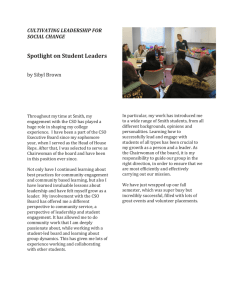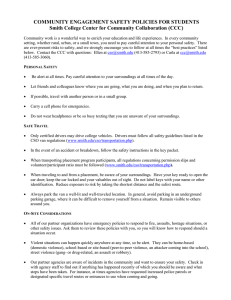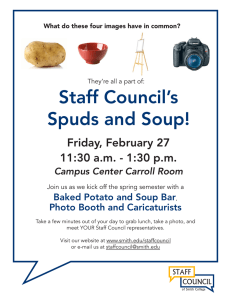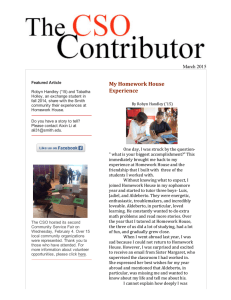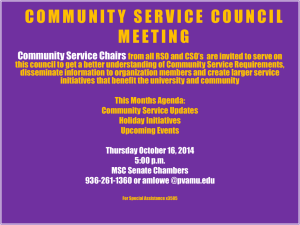January 2010
advertisement
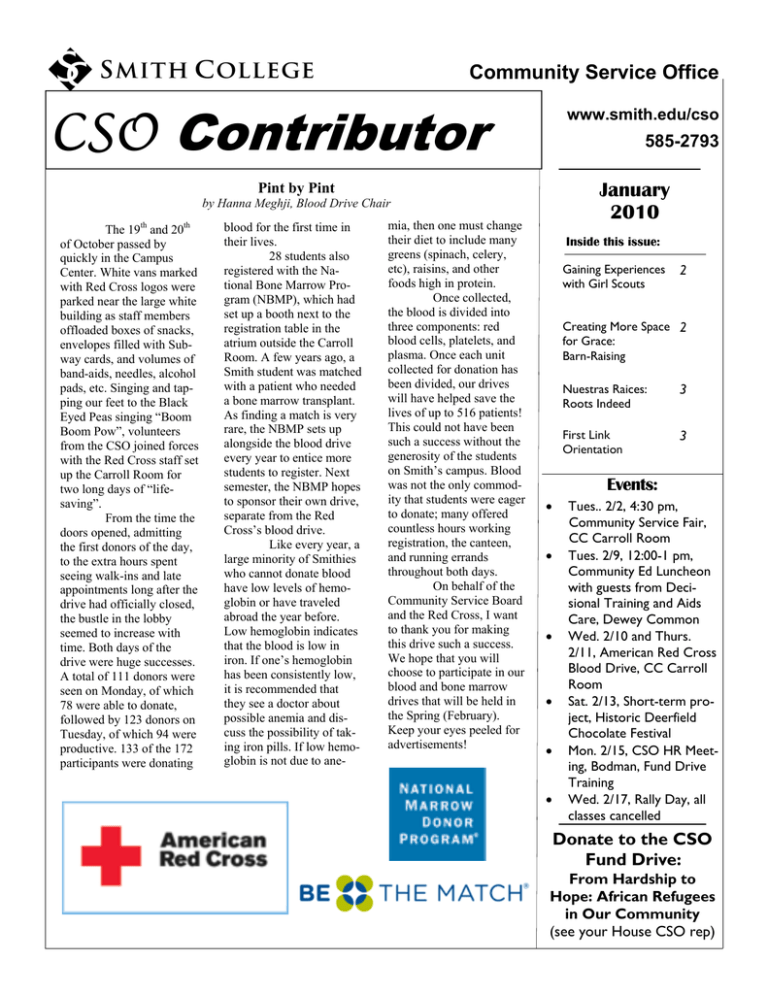
Community Service Office CSO Contributor Pint by Pint by Hanna Meghji, Blood Drive Chair The 19th and 20th of October passed by quickly in the Campus Center. White vans marked with Red Cross logos were parked near the large white building as staff members offloaded boxes of snacks, envelopes filled with Subway cards, and volumes of band-aids, needles, alcohol pads, etc. Singing and tapping our feet to the Black Eyed Peas singing “Boom Boom Pow”, volunteers from the CSO joined forces with the Red Cross staff set up the Carroll Room for two long days of “lifesaving”. From the time the doors opened, admitting the first donors of the day, to the extra hours spent seeing walk-ins and late appointments long after the drive had officially closed, the bustle in the lobby seemed to increase with time. Both days of the drive were huge successes. A total of 111 donors were seen on Monday, of which 78 were able to donate, followed by 123 donors on Tuesday, of which 94 were productive. 133 of the 172 participants were donating blood for the first time in their lives. 28 students also registered with the National Bone Marrow Program (NBMP), which had set up a booth next to the registration table in the atrium outside the Carroll Room. A few years ago, a Smith student was matched with a patient who needed a bone marrow transplant. As finding a match is very rare, the NBMP sets up alongside the blood drive every year to entice more students to register. Next semester, the NBMP hopes to sponsor their own drive, separate from the Red Cross’s blood drive. Like every year, a large minority of Smithies who cannot donate blood have low levels of hemoglobin or have traveled abroad the year before. Low hemoglobin indicates that the blood is low in iron. If one’s hemoglobin has been consistently low, it is recommended that they see a doctor about possible anemia and discuss the possibility of taking iron pills. If low hemoglobin is not due to ane- mia, then one must change their diet to include many greens (spinach, celery, etc), raisins, and other foods high in protein. Once collected, the blood is divided into three components: red blood cells, platelets, and plasma. Once each unit collected for donation has been divided, our drives will have helped save the lives of up to 516 patients! This could not have been such a success without the generosity of the students on Smith’s campus. Blood was not the only commodity that students were eager to donate; many offered countless hours working registration, the canteen, and running errands throughout both days. On behalf of the Community Service Board and the Red Cross, I want to thank you for making this drive such a success. We hope that you will choose to participate in our blood and bone marrow drives that will be held in the Spring (February). Keep your eyes peeled for advertisements! www.smith.edu/cso 585-2793 January 2010 Inside this issue: Gaining Experiences with Girl Scouts 2 Creating More Space 2 for Grace: Barn-Raising Nuestras Raices: Roots Indeed 3 First Link Orientation 3 Events: Tues.. 2/2, 4:30 pm, Community Service Fair, CC Carroll Room Tues. 2/9, 12:00-1 pm, Community Ed Luncheon with guests from Decisional Training and Aids Care, Dewey Common Wed. 2/10 and Thurs. 2/11, American Red Cross Blood Drive, CC Carroll Room Sat. 2/13, Short-term project, Historic Deerfield Chocolate Festival Mon. 2/15, CSO HR Meeting, Bodman, Fund Drive Training Wed. 2/17, Rally Day, all classes cancelled Donate to the CSO Fund Drive: From Hardship to Hope: African Refugees in Our Community (see your House CSO rep) January 2010 Page 2 GAINING EXPERIENCES WITH GIRL SCOUTS by Anna Valentine and Danielle Santos, CSO Volunteers When we first got to Smith in 2007, we set out in search of a community service opportunity through the CSO fair. Little did we know that we would end up working with a local troop of Girl Scouts ages 12-14 (in 6th –8th grade) for the next two years in nearby Florence. The girls had been together since they were Daisy’s (kindergarten). Unfortunately, our involvement with Girl Scouts has drawn to a close this year, but the experiences we had with Troop 536 will stay with us for years to come. Over the past two years we have learned many invaluable skills such as orienteering, cooking outdoors and how to coerce our housemates into buying cookies. Nothing, though, compares to the leadership skills we’ve gained and the joy we’ve received from watching our girls grow with the completion of each interest project badge. However, it wasn’t always easy considering the wide array of interests each girl brought to the group. In light of this, we learned how to address everybody’s needs while keeping each project fun for everyone involved. One of the advantages of doing long term community service projects is getting to see the result of our efforts played out over time. We’ve witnessed this in the confidence that our girls have gained from being in Girl Scouts as well as their heightened appreciation for doing community service themselves— a required component of the interest project badges. Besides what they learned through completing their badges, the girls also indirectly learned how to work cooperatively and creatively with others in the group. Even though we felt that significant amounts of progress weren’t always made during weekly meetings, we recognize that our presence as role models for growing adolescent girls made an equally important impact on the troop. The experience we’ve had with Girl Scouts will serve us well in our lives after Smith. While we may not necessarily have jobs working with children, the expertise that we have gained in facilitating group discussion and thinking on our feet will be invaluable to us as future women of the workplace. CREATING MORE SPACE FOR GRACE: BARN-RAISING by Dana Steuhling, Short Term Projects co-Chair On October 4, CSO sent three students to volunteer at Grace House, a local agency dedicated to helping mothers recovering from substance abuse. Grace House, a partner agency of Smith's CSO, is a residential substance abuse treatment program for recovering women and their children. Its unique family recovery program focuses on reuniting women overcoming their addictions with their children. In an effort to expand the treatment center, a barn was built for storage of equipment and furniture. The barn raising, which occurred every weekend for about six weeks, involved youth and adults from Smith, St. John's Episcopal Church, and the local community. Built completely by volunteers, the 12x24-foot red barn now stands just feet from the edge of campus. The students who participated in the barn raising, Alanna McFall, Kristen Rosa, and Dana Steuhling hard at work on the barn. Dana Stuehling spent a cloudly October morning learning how to shingle the roof. They spent the rest of their time cutting the shingles, using chalk lines to ensure the shingles were straight, and hammering the shingles into the roof. Two weeks later, the project was completed. With the combined effort of many volunteers, the barn is now in full use and is a valuable asset to the Grace House community. Completed barn gleams in sunlight January 2010 Page 3 Nuestras Raices: Roots Indeed by Phoebe Camilletti, Short Term Projects co-Chair During the month of September, Dana Stuehling and I led a large group of students to Nuestras Raices, a thriving farm community in Holyoke, as our first short-term project for the year. The adventure over to the city was a huge success; we did a variety of tasks such as, but by no means limited to, weeding, constructing a tent, and removing refusefrom the farm. The C.S.O. has a long tradition of sending students to volunteer at Nuestras Raices and the experience is always well-received—even by those who don’t particularly like getting dirty! All the volunteers enjoyed this time around in particular, and since we took so many first-years, we’re hoping they will want to either go back or continue their service involvement—or both! While I very much enjoyed the tasks that we did together, I was most inspired by a particular theme that popped up during the course of the day. When Amy Callandrella introduced us to the farm and showed us around, she mentioned that so many of the things on the farm that you wouldn’t expect to be edible actually are edible. She broke a flower off a nearby stem and started chewing it, encouraging us to find one and taste it too. As we walked through the farm, she kept pointing out a wide variety of vegetation, calling it by name and giving us information about it. Amy made the very interesting point that the American agricultural industry revolves around crops that are expensive to produce and not as healthy as they could be, whereas there are many varieties of fruits, vegetables, and the like that could be produced instead for greater benefit all-around. She also mentioned that so much of what we use as landscape adornment in America is really superfluous--sapping the land of nutrients for little gain--and that there are many attractive, edible plants that we could use for our decoration instead. The root of this matter seems to be that our unsustainable means of living are everywhere-even where we might not be inclined to look. It's interesting to contemplate exactly what fuels any system of commerce, whether it be agricultural or otherwise; in this case, though, to what extent are we deluding ourselves? The options are out there and yet we insist on maintaining systems that sometimes are unproductive or even detrimental. This being said, there are non-profit organizations like Nuestras Raices, committed to approaching food production in a very sustainable, community-centered way. These are too often neglected. The work Smith volunteers do with organizations like this, however, gives me some hope that awareness will increase and we'll begin to foster more humanistic means of doing just about anything that's worth doing on this earth. The question remains, though: how will we manage to achieve what should be very root of a sustainable society? Community Service Fair Smith College, Carroll Room February 2nd, 2010 4:30-6:00pm FREE PIZZA WHILE IT LASTS! Come learn how you can utilize your time to make an impact! Help our surrounding communities while doing something you like! Tutoring, farming, childcare, medical, Aids Care... You name it, You’ll find it! Nuestras Raíces is a grass-roots organization that promotes economic, human and community development in Holyoke, Massachusetts through projects relating to food, agriculture, and the environment. First Link Orientation and the Prison Book Project by Paula Gonzalez Del Real What does it mean to do something for someone else? At the beginning of the year, I packed all of my belongings into two large suitcases, traded my summer earnings for a laptop, boarded two different planes with connecting flights, and found myself in Northampton Massachusetts at college, more specifically, Smith College. For my orientation group I chose First Link because the description in the packet mentioned community service. As a foreigner to the east coast I was attracted to the idea of getting used to the area by meeting the people who work to make it better. The first day, I got the chance to meet leaders from several distinct organizations ranging from an independent woman who managed an urban agriculture program called Nuestras Raices to an Aids Care program. I remember chatting excitedly with my neighbors trying to decide which organization we would want to help with most. I always want to know, where can I do the most good? Luckily for me, every organization I discovered seemed just as amazing and just as novel as the next. In the morning my group piled in Smith Vans and drove to (Continued on page 4) Page 4 First Link Orientation Continued from page 3 a small North Hadley church building where an organization called Prison Book is located. Debbie Richards, the site coordinator explained that like the title implies, Prison Book takes requests for books from people in prisons around the country and sends them their orders. Due to some setbacks, they had run behind so the letters requesting books were overflowing. I think when most people laid eyes on the huge stacks of boxes before us; they felt a sense of urgency. The idea of going through letters seemed intriguing and proved to be an intense experience for all of us the moment we started reading our first “Dear Prison Book.” After only a few minutes of opening envelopes and struggling through sometimes near illegible handwriting I looked around and saw that the room and the people around me were all silent with a sort of reverence. Most of us didn’t know what to expect. Unless you’ve been in prison for a time yourself (which I’m guessing most of us have not) it’s hard to imagine what day to day life is like and how books play a part. With each letter, I quickly came to understand just how important these books are for their recipients. Some people wanted textbooks so they could educate themselves, others sci-fi novels, mysteries, or cookbooks. The most amazing thing to me was the importance of the letters themselves. Each envelope had to be addressed perfectly so we could send books to the right recipient. Furthermore, each package of books could only weight a certain amount and contain books from an approved list. To this end, each letter had with it a sense of importance and significance that you can’t get in an email or a text message. The hope in the requests gave many people in prison something good to look forward to. Prison book made me remember that it’s too easy for people to get caught up in their individual worlds. Especially in a culture that places emphasis on individual January 2010 achievement we sometimes forget that success, happiness, and hope is not something that can be attained by individual effort alone. Around the world, any individual’s greatest potential assets are the people around them. I’ve found that when a community, even a community of strangers work together to do something for a cause or an organization; they not only gain that warm cozy feeling of helping others but also form relationships of the best kind. It was through First Link that I first came to understand the great potential of what I can do with my community and with my abilities to help others in my time here at Smith College. Decisional Training/Thresholds: Work with Inmates Interested in working with inmates to learn decision-making, problem-solving, and life-planning skills? Training for this program is February 27th and 28th and last day for the semester is in first week of May. For more information, contact Sherrill Ashton at 582-3053 or Janet Dahlberg at 586-1640. For transportation info, go to www.smith.edu/cso/trans.htm or call x2793. CSO Accepting Applications for 2010-2011 Executive Board www.smith.edu/cso for more info Help Save a Life CSO Blood Drive Wednesday, February 10th 11 am – 5 pm Thursday, February 11th 1 pm – 7 pm Carroll Room, Campus Center Appointments are recommended and will be taken first, but walk-ins are always welcome. For more specific donor information, check out www.givelife.org or call 1-800-GIVELIFE, or email sos@smith.edu POSITIVE ID REQUIRED Winter Gifts Partnership with Hilltown Churches’ Pantry This year, as in the past, the C.S.O. participated in the Winter Gifts program with the Hilltown Churches’ Pantry. Through the generosity of 17 houses and 15 student organizations, faculty, departments, staff members, and individuals, 52 children were sponsored and provided with presents this holiday season. Thanks to all who contributed to this great cause during these difficult economic times. Also, thanks to Molly Sauvain, Head of House Reps; Dana Stueling & Phoebe Camilletti, Short Term Projects Co-Chairs and Bonnie Coleman from the Pantry for all the help, emails, and coordinating. THANK YOU ESPECIALLY TO ALL SPONSORS Most of those using the pantry are working poor and many have more than one job. Sizes of families can vary from one to ten and a recent trend is for families to move in with each other to save costs, including transportation to and from the pantry to pick up food. The Pantry is an all volunteer organization providing food to residents of the Western Franklin County Hilltowns and is located in rural Ashfield.
